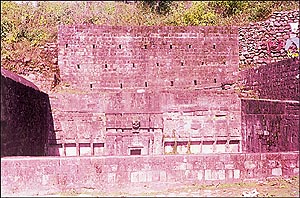 |
| Saturday, January 29, 2000 |
|
 |
VISITING Kangra Fort is like going
down the annals of history. Most of it was destroyed in
the earthquake of 1905, but whatever of it is left
ignites one’s imagination and creates an aura of
mystery. Kangra Fort is also known as Kot Kangra or
Nagarkot. Its reference exists in the Mahabharta, which
states that The Tomars of Delhi
seized it from him and passed the control to the Katoch
rulers. There has been a long line of conquerors of the
fort after that. Akbar’s general Khan-e-Jahan
besieged it in 1572, and in 1615, Jahangir’s general
Sikandar Murtaza made an unsuccessful bid to gain control
of it. Jahangir himself captured it in 1620. Sansar Chand
II, the Katoch ruler, recaptured the fort from its Mughal
governor in 1785. Amar Singh Thapa of Nepal besieged it
from 1805, The fort occupies a large area enclosed with walls over a circuit of about 4 km. As you enter, there is a hamam, which consists of an open tank with three rooms in front of the main gate. The gate, presumably built by Sikhs, is known as Ranjit Singh Gate. There is a passage beyond the gate which has impressive stone carvings of Lord Hanuman and Ganesha on its sides. |
The passage goes through the Amiri
Darwaza built in the times of Nawab Alif Khan, the
first Mughal governor of Kangra. The path through Andheri
Darwaza reaches Darshani Darwaza which leads
to the Laxminarayan temple, dating back  to the ninth-tenth century. The temples
contains the shrines of Ambika devi and Adinath.
On the left side of the temple is a platform with a pair
of pillars. It was supposedly the durbar hall. As
many as 105 carvings sculpted on stone have been salvaged
by the ASI and kept in a shed. About 35 of them are being
retouched. to the ninth-tenth century. The temples
contains the shrines of Ambika devi and Adinath.
On the left side of the temple is a platform with a pair
of pillars. It was supposedly the durbar hall. As
many as 105 carvings sculpted on stone have been salvaged
by the ASI and kept in a shed. About 35 of them are being
retouched.Beyond the temple is the Sheesh Mahal and towards the south-west is the polygonal watch tower overlooking the spectacular valley. There is also a mosque, which was built during Jahangir’s time, the Kapoor Sagar Tank and Phansi Ghar. |